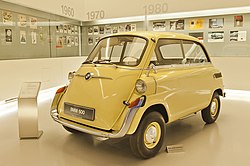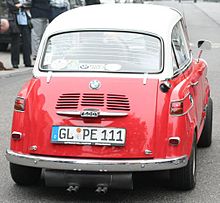BMW 600
| BMW | |
|---|---|
|
BMW 600 in the BMW Museum
|
|
| BMW 600 | |
| Production period: | 1957-1959 |
| Class : | Small car |
| Body versions : | limousine |
| Engines: |
Otto engine : 0.6 liters (14 kW) |
| Length: | 2900 mm |
| Width: | 1400 mm |
| Height: | 1375 mm |
| Wheelbase : | 1700 mm |
| Empty weight : | 550-560 kg |
| successor | BMW 700 |
The BMW 600 was a four-seater small car (according to today's definition, a small car ) developed by the Bayerische Motoren Werke based on the model of the BMW Isetta . To enter it had a front door and a side door at the rear right. The engine design was largely based on the BMW boxer motorcycle engines , but the car engines were short-stroke and equipped with a throttle valve carburetor. The vehicle was built from December 1957 to November 1959. The BMW 700 with a longer wheelbase, side doors and self-supporting body replaced the BMW 600.
history
As early as 1956, BMW developed prototypes based on the Isetta for the construction of a four-seater vehicle with front entry and a new rear axle as well as an air-cooled boxer engine. One still had a folding roof like the Isetta and free-standing headlights; the side door was missing. The name of the pre-war series "Dixi" was temporarily shortlisted as the name of the car.
Two years after the introduction of the Isetta , BMW presented the BMW 600 to invited press representatives on August 27, 1957 in Feldafing on Lake Starnberg.
engine and gears
The air-cooled two-cylinder boxer engine with a central camshaft driven by spur gears and V-shaped hanging valves is installed lengthways behind the rear axle. The cooling fan is located behind the engine and is driven directly by the crankshaft, with the air filter above it. The gearbox with mechanically operated single-disk dry clutch and differential is flanged to the front of the engine. It has center shift , four synchronized forward gears and one reverse gear. The rear wheels are driven by two shafts with two rubber joints ( Hardy disks ) each.
Chassis and body
The BMW 600 has a box frame made of lengthways square steel tubes. The wheels are each suspended at the front on a pushed swing arm in the manner of a Dubonnet suspension (the whole swing arm is rotated for steering and not just the wheel carrier) and at the rear on broadly mounted triangular drawn longitudinal swing arms. The suspension consists of coil springs with telescopic shock absorbers on all wheels and additional rubber damping elements at the rear.
The body is a closed all-steel structure (with folding sunroof on request) with a front door that opens to the left and a right rear side door hinged at the front. The steering wheel and dashboard swivel outwards when the front door is opened. The spare wheel is located inside the front door behind a cover. The tank is installed above the engine.
The car has a bench seat for two people at the front and rear. The space on the back seats was described as generous in a contemporary test report, according to Paul Simsa in auto, motor und sport “more than in the usual two-door small car”. The luggage rack behind the rear seat is very small with a capacity of 100 liters, according to the factory. For enlargement, the seat back can be folded forward or the entire rear seat can be removed.
Vehicle data
| BMW 600 | Data |
|---|---|
| Engine: | 2-cylinder boxer engine (four-stroke) in the rear |
| Displacement : | 585 cc |
| Bore × stroke: | 74 × 68 mm |
| Power: | 14.4 kW (19.5 hp) at 4500 rpm |
| Maximum torque : | 38 Nm (3.9 mkp) at 2800 rpm |
| Carburetor : | 1 flat-flow carburetor Zenit 28 KLP 1 |
| Compression: | 6.8: 1 |
| Valve control: |
OHV (lower camshaft , bumpers and rocker arms) |
| Cooling: | Air (blower) |
| Electrical system: | 12 V crankshaft start generator (Bosch Dynastart ) |
| Transmission: | Four speed with reverse gear |
| Front suspension: | pushed longitudinal swing |
| Rear suspension: | broad-based drawn longitudinal swing arms, mounted in rubber |
| Suspension: | Coil springs |
| Steering: | Spindle steering, undivided tie rod |
| Brakes: | Drum brakes, hydraulically operated, Ø 180 mm, braking area 432 cm² |
| Body: | Tubular steel frame with all-steel body |
| Track width front / rear: | 1220/1160 mm |
| Wheelbase : | 1700 mm |
| Wheel size: | 5.20–10 ″ |
| Dimensions L × W × H: | 2900 mm × 1400 mm × 1375 mm |
| Empty weight (without driver): | 550 kg (factory information: 560 kg) |
| Top speed: | 103 km / h (factory specification: 100 km / h) |
| Price: | 3985 DM |
- At the time of the market launch, BMW reported slightly different values.
reviews
According to contemporary test reports, the vehicle ("large Isetta ") was characterized by good workmanship and excellent road holding. The fully synchronized gearbox and the asymmetrical dipped beam were technically advanced - neither of which was available on German small cars until then. Because of its idiosyncratic, space-saving design with a front door and only one side door for the rear seats, the BMW 600 found relatively few buyers. Another reason for the low number of sales was probably that the car at 3985 DM cost almost as much as a VW Standard . The VW offered more space for people and luggage, the BMW 600 only had a small storage recess behind the back seat. 34,813 copies were produced in the almost two-year construction period. Upon request, the vehicle could be supplied with the automatic clutch Saxomat , a convenience that was not very popular with buyers.
4020 vehicles in a special version for export overseas were equipped with bumper bars and sealed beam headlights .
literature
- Werner Oswald: BMW 600 [and BMW-Isetta] . (= The Motor Test, Issue 11). Motor-Presse-Verlag, Stuttgart 1959, 32 pages
- Hans Stadlinger: Everything about the BMW 600 . (= "Auto von heute" series of publications, issue 5) Ibera-Verlag, Vienna [around 1959], 16 sheets
- Paul Simsa (with Jan Friedrich Drkosch): Five small German cars. BMW 600, Fiat 600, Goggomobil T. 600 / T 700, Lloyd Alexander TS, NSU Prinz and Prinz 30 (= Der Motor-Test, Issue 12) Motor-Presse-Verlag, Stuttgart 1959, 32 pages
- Georg Seeliger: Cars that made history - BMW Isetta, 600 & 700 small cars . Motorbuch-Verlag, Stuttgart 1993, 122 pages. ISBN 3-613-01500-5
- Reinhard Lintelmann: The scooters and small cars of the fifties . Verlag Walter Podszun, Brilon 1995, ISBN 3-86133-136-5
- Reinhard Lintelmann: BMW Isetta and BMW 600/700 . Komet Verlag GmbH, Cologne, ISBN 978-3-89836-903-9
- Walter Drawer: BMW Isetta and its competitors . Schrader-Motor-Chronik, Stuttgart 1996, ISBN 3-613-87010-X
- Siegfried Martin Winter : With 600 cubic meters through both America . Brockhaus, Wiesbaden 1960
Web links
- BMW 600. In: BMW History. BMW AG, accessed on July 3, 2016 (dossier in the BMW Group archive with technical data).
- Operating Instructions BMW 600. In: BMW History. BMW AG, May 1958, accessed on July 4, 2016 (owner's manual with pictures, 38 pages).
- Spare parts list BMW 600. In: BMW history. BMW AG, May 1963, accessed on July 4, 2016 (spare parts list with pictures, 166 pages).
- BMW 600 class winner in the Int. Caltex Economy Test 1959. In: BMW History. BMW AG, March 24, 1959, accessed on July 4, 2016 (press release in the BMW Group Archive).
- Lots of detailed information about the BMW 600
Individual evidence
- ↑ BMW 600 prototype. In: BMW history. BMW AG, 1956, accessed on April 12, 2020 (photo in the BMW Group Archive).
- ↑ "Dixi" model (predecessor BMW 600). In: BMW history. BMW AG, 1956, accessed on April 12, 2020 (photo in the BMW Group Archive): "Model of an" enlarged Isetta "based on ideas from Sales Export (Dr. Krüger, Graf Hallwyl)."
- ↑ Press kit: Presentation of the BMW 600. In: BMW History. BMW AG, August 27, 1957, accessed on July 5, 2016 (document in the BMW Group Archive with technical data, 57 pages): "Please note the embargo: Echte Morgenzeitungen August 31, 1957"
- ↑ a b sales brochures and test reports, printed in Schrader-Motor-Chronik , Schrader Verlag, Stuttgart 1996, ISBN 3-613-87010-X .
- ↑ Automotive splinters - some details from the small car BMW 600 . In: Motor Vehicle Technology 7/1958, pp. 267–268.
| Timeline of the glass series models from 1955 to 1969 | |||||||||||||||||||||
|---|---|---|---|---|---|---|---|---|---|---|---|---|---|---|---|---|---|---|---|---|---|
| Type | independent (Hans Glas GmbH) | BMW | |||||||||||||||||||
| 1950s | 1960s | 1970s | |||||||||||||||||||
| 5 | 6th | 7th | 8th | 9 | 0 | 1 | 2 | 3 | 4th | 5 | 6th | 7th | 8th | 9 | 0 | 1 | 2 | 3 | 4th | ||
| Microcar | Goggomobil T | ||||||||||||||||||||
| Small car | Isar ("large Goggomobil") | ||||||||||||||||||||
| Lower middle class | 1004, 1204, 1304 | ||||||||||||||||||||
| Middle class | 1700 | 1800 SA, 2000 SA / 1804, 2004 [1] | |||||||||||||||||||
| Coupe | Goggomobil TS | ||||||||||||||||||||
| 1300 GT, 1700 GT | 1600 GT [2] | ||||||||||||||||||||
| 2600 V8, 3000 V8 | 3000 V8 [3] | ||||||||||||||||||||
| Vans | Goggomobil TL | ||||||||||||||||||||
|
|
|||||||||||||||||||||






